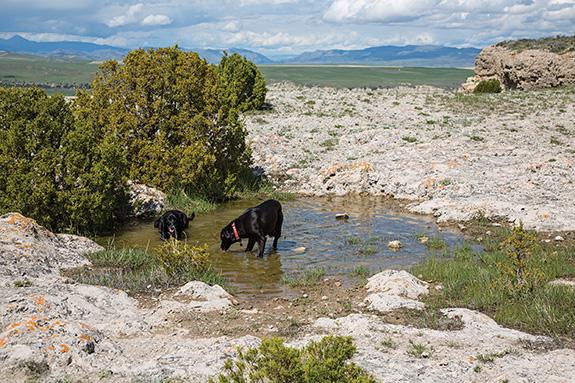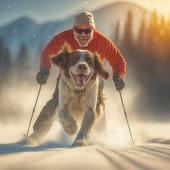Keep It Cool
Summer safety tips for dogs.
Caring, active owners, great outdoor recreation, and relatively few parasites and infectious diseases make a dog's life in Montana a little more comfortable than in other parts of the country. Our cool and dry climate helps our dogs stay cooler too.
Dogs don't sweat, except for on their feet; they use evaporative cooling from their tongues instead. That's why dogs overheat quickly in humid conditions. But even in our dry climate, heat exhaustion does occur. Knowing how to prevent, recognize, and treat it is a must.
Technically heat exhaustion and dehydration are different, but for the average pet owner they are the same. The key to recognizing a problem is to know your dog under normal conditions. His attitude, panting, alertness, gum color, and moisture level should be familiar to you. Be brave and invest in a thermometer for your dog's first-aid kit. A drugstore digital model will be fine. A dog's normal body temperature taken via the rectum is between 100 and 102.5 degrees Fahrenheit. There is a difference between surface and core temperatures, and because our human temperatures are usually lower, a dog (or cat) will almost always feel warm to the touch. On a warm day, an active young dog's temperature might get up to 103.5 without a problem, but depending on age, fitness level, and hydration, 103.5 might be getting toward dangerous territory. Other major signs of heat exhaustion include noisy and excessive panting, weakness, vomiting, stumbling, and collapse.
Proper hydration, avoiding exercise at the peak hours of sun and heat, and proper conditioning can prevent heat exhaustion. The average dog at rest drinks between one-half to one cup per 10 pounds of body weight per day. As activity and outside temperature increases, water consumption will too. An average Nalgene holds about four cups; combined with water found on the trail, this should be enough to get a medium to large dog through a half-day of activity in moderate temperatures. As temps get into the 90s and 100s, consider exercising your dog only in the cool morning or evening hours. One way to increase fluid intake is by soaking dry dog food in water for 10-15 minutes before feeding.
If you see signs of heat exhaustion beginning in your dog while you are out on the trail, stop what you're doing. Make your dog sit or lie down, preferably in the shade. If there is water nearby, submerge her in it, but try to prevent gorging on water. Too much water too fast can induce vomiting, which can make dehydration worse. Water or rubbing alcohol on the paw pads, armpits (all four), and ear flaps aids cooling. Give small amounts of water until signs begin to subside. If true neurologic signs are present, such as stumbling, seizurelike trembling, or severe disorientation that don't resolve quickly with rest and water, get to a veterinarian as soon as you can.
Liz Layne has been a vet in the Gallatin Valley for almost 20 years.
Walk this Way
by the editors
If you do take the dog on a summer outing, certain trails are better than others. For example, you don’t want to find yourself high up on the Bridger ridge mid-day. Stick to shaded paths close to creeks and other water bodies. Keep in mind that creeks full of water in the spring will be much lower or nonexistent by late summer. Trails that gain a lot of elevation can also be problematic because your dog will be working extra hard, and once you’re up high, tree cover thins out substantially.










